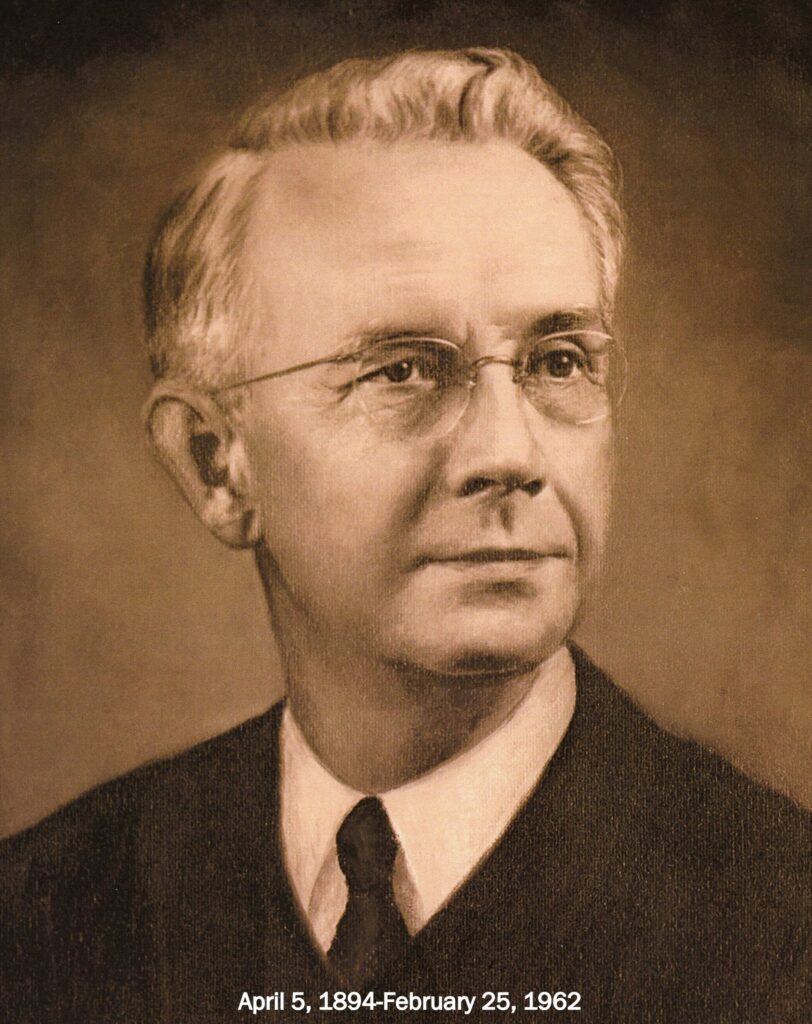By Gloria Colvin, Chair of the Bicentennial Publicity Committee and Dr. Lynn McLarty, Church Historian
During the post-war years, Tallahassee and Trinity continued to grow. In 1945 Trinity purchased the remaining 75’ of the lot immediately to the north which allowed the church to finally work toward building an educational complex. Our Trinity Hall was dedicated in October 1949. In 1948 the church purchased the western 85’ of the lot at the southeast corner of Call and Duval. A home on the lot was used as a staff residence, and it later became the Terrell House. In 1956, the opportunity arose for the church to buy the lot north of Trinity Hall. The home on the lot was torn down, but the garage apartment remained to become the Scout House. To allay the need for more parking for the congregation, in 1957 and 1958 the church purchased three lots at the southwest corner of Call and Duval.
From the time Dr. Glenn James came to Trinity in 1953, he was determined to build a new sanctuary and chapel. All Quarterly Conference Minutes during the ensuing years consistently mentioned the construction of a new sanctuary as well as a chapel. Progress toward this goal solidified and monetary commitments for its construction bounded beyond expectation. Following his sudden death in February 1962, work to build the sanctuary, fellowship hall, offices, and a chapel continued. On May 3, 1964, the new sanctuary was consecrated. The chapel was named in memory of Dr. James.

As Tallahassee grew, Trinity helped establish additional Methodist churches. In 1947 Trinity aided in the formation of Tallahassee Heights Methodist. In 1952 Trinity sponsored the formation of St. Paul’s Methodist Church and provided financial support for three years. Together St. Paul’s and Trinity helped establish John Wesley Methodist Church in 1960. Several Trinity members left to help support this new church, and Associate Pastor Danny Morris became John Wesley’s first pastor. As a joint effort by Trinity and the Tallahassee District, Calvary Methodist Church became a reality in 1964. The next year Trinity helped start Gray Memorial Methodist Church. The formation of Killearn United Methodist Church followed in 1969. Some time lapsed before Trinity supported the formation of Killearn Lakes United Methodist Church, later Deer Lake UMC, in 1987.
One hundred years had passed since the Civil War, and the issues of racial discrimination and segregation were again in the forefront of public debate. Jim Crow segregation was pervasive in most aspects of life in the South. Trinity, like most Southern churches, did not have Black members or even Black people who attended the church. Dr. Glenn James was Senior Pastor of Trinity when several Black people arrived one Sunday to attend a worship service. Some members present that day recall that he told ushers not to turn anyone away and to seat the visitors up front. Several people walked out of the church in protest, but most remained. Dr. James also spoke to the congregation about the church’s failure to address the issue of race before then and noted that the way we treated Black people was a faith issue.
Integration in Tallahassee progressed slowly through the 1960s as desegregation of schools, a bus boycott, and lunch counter sit-ins brought racial inequality into focus. Dr. H. Melton Ware, Trinity’s Senior Pastor from 1962 to 1965, recalled that during his tenure, people throughout Tallahassee were discussing the demands for racial equality. “The Trinity congregation,” he wrote, “faced the issue frankly and remained faithful to the Scriptural ideal of acceptance of and compassion for all people of all races. The leadership of the Trinity congregation was outstanding during those years, which proved to be important to the church. The members were loyal, faithful, and generous in their support.”
Dr. George Foster succeeded Dr. Ware as Senior Pastor in 1965 and led Trinity through the rest of the Civil Rights era and through the administrative changes that were made in the Methodist Church nationally and in Florida in the late 1960s. A dynamic preacher and popular speaker, Dr. Foster served the last of four terms as a General Conference delegate while at Trinity and kept the church aware of needed social reforms.
As a result of the 1939 unification of the Methodist Episcopal Church and the Methodist Episcopal Church South, a Central Jurisdiction had been established to administratively segregate Black members within the church. Following calls to abolish the Central Jurisdiction in favor of a racially inclusive church at the 1964 General Conference, the Florida Conference passed a resolution in 1966 to unite with the Florida Conference, Central Jurisdiction. In 1968 the Methodist Church and the Evangelical United Brethren merged to form the United Methodist Church and Trinity became Trinity United Methodist Church. The familiar logo of the cross and flame was introduced at the time of this merger. The following year, the Florida Conference united with the Florida Conference of the Central Jurisdiction, ending years of segregation within the church.
Foreign missions were an area of focus for Trinity during this time, and Cuba was of particular interest due to the political unrest there. The church supported Rev. Richard Milk and the Methodist Agricultural and Industrial School in Preston, Cuba for a number of years until Rev. Milk had to leave following Fidel Castro’s rise to power. Trinity also held annual church-wide mission studies focusing on different regions of the world, including Africa and South America.